Dec-31-07
 | | tamar: 33 Nd2 is a casual virtuoso move, giving Mason who has done well so far, the option to take the b pawn. Can Black survive if he does? 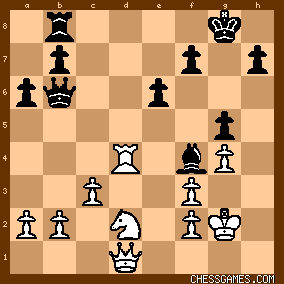
click for larger viewIf 33...Qxb2 34 Ne4 Kg7 35 Rb4 Qxa2 36 Qd4+ e5 37 Qd6 Re8 38 Qf6+ Kg8 39 Nd6 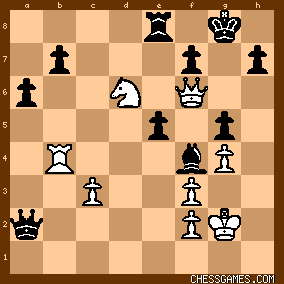
click for larger view With the threats of 40 Nxe8 and 40 Nf5 it becomes apparent that Pillsbury has seen it to mate, or loss of heavy material. |
|
Oct-19-17
 | | KEG: Pillsbury (who had 4 1/2 out of 5 going into this game) had been living on the edge in this tournament, winning games in which he had been dead lost against Didier and Maroczy in the prior two rounds. Here, he gets outplayed by Mason in the opening and the early middle-game. He manages to reduce the game to an even King-and-Pawn ending, and then works his endgame magic to defeat Mason in what looked like a drawn position. As always, Pillsbury was dangerous in the endgame. 1. d4 e6
2. e4
Pillsbury elects to play against a French Defense. 2... d5
3. Nc3 Nf6
4. Bg5 Be7
5. BxN
5. e5 is generally considered better (e.g., MCO-13 and Gligoric in his book on the French Defense). Notably, Rosenthal in the Tournament Book, perhaps reflecting the opinion of the day, claims that the text is best and that 5. e5 favors Black. 5... BxB
6. Nf3 0-0
Both Gligoric and Rosenthal in the Tournament Book question this move and prefer 6...c5. Once again I respectfully disagree. While 6...c5 looks reasonable, I see nothing wrong with the text. 7. Bd3
Gligoric says the text is best, but I yet again respectfully dissent. 7. Qd2 allows rapid Queen-side castling and seems more logical. 7... dxe4
Gligoric prefers 7...c5. Rosenthal prefers the text and condemns Gligoric's move. Both alternatives look OK to me. 8. Bxe4 c5
9. dxc5 Qa5
Reasonable, but 9...Nd7 is less committal and probably best. 10. 0-0 Qxc5
10...BxN mangling White's Queen-side pawn structure looks best. 11. Qd3
11. Rb1 would inhibit Black from playing BxN since that would now give White's Rook a dangerous open file. 11... g6
12. Ne2?
Some of Pillsbury's moves in the early stages of this tournament are inexplicable. Why this weak move that gives Mason two ways to secure a big advantage and that does little to advance White's cause. 12... Bg7
Why this worried move by Mason when he had two good alternatives. He could have played 12...Bxb2 (as recommended by Rosenthal) after which 13. Rab1 Bf6 14. Bxb7 BxB 15. RxB Rd8 gives Black the far superior position. If Mason didn't want to go in for that, he could have played 12...Na6 developing his Knight while retaining the two Bishops and again much the better game. 13. Qb3 Nd7
14. c3 Nf6
15. Ng3 Rb8
16. Rad1 Bd7
17. Rfe1 Rfd8
18. h3 Qa5
Rosenthal prefers 18...Nxe4, but the text seems about as good. 19. Bc2
Another questionable move by Pillsbury. (19. Nd4 was best). At this stage of the tame, Mason had clearly obtained a major edge. How and why Mason relinquished his advantage and winning chances will be discussed in my next post on this game. |
|
Oct-19-17
 | | KEG: After Pillsbury's 19. Bc2, the position was as follows: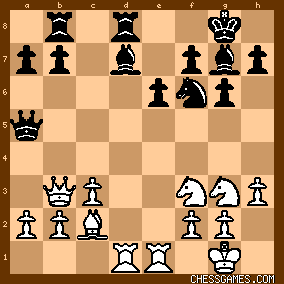
click for larger viewMason clearly has the better game. What can he make of it? 19... Qc7
Why this retreat? 19...Bc6 was better.
20. Ne5 Be8
21. Ng4
Pillsbury is truly tempting fate here. He allows Mason to mess up his King-side pawns and trade off a few pieces. Definitely stronger was 21. Qc4, though Mason would still have the better game. 21... NxN
A good alternative was 21. Nd5, but Mason's move obviously has its points (i.e., maintaining his advantage, doubling the White g-pawns, and cutting down Pillsbury's attacking chances). 22. hxg4 RxR
23. BxR Be5
24. Nf1 Bc6
25. Qc4
Another poor move by Pillsbury. Having played 21. Ng4, he had to play 25. Bf3 here. Now Mason has very serious winning chances. 25... Qd6
Missing his chance to take control with 25...b5. The text has little or nothing to recommend it. Pillsbury is now back in the game, and from here on plays like the Pillsbury we have all come to know and love. 26. Bf3
Pillsbury should have played this on his last move. He seizes the opportunity here. 26... BxB
27. gxf3 Bf4
27...Rd1 was stronger.
The position was now as follows:
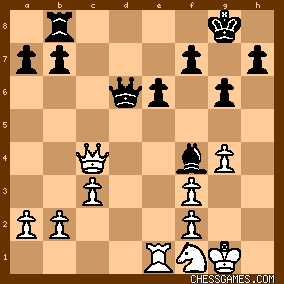
click for larger viewMason is still better, but Pillsbury seems to be past the worst. But how did Pillsbury manage to win this game? I will attempt to begin an explanation in my next post on this game. |
|
Oct-20-17
 | | KEG: Post III
Pillsbury was very much alive after 27...Bf4, but Mason still had the better game. But Pillsbury, as always, played to win.
28. Qa4
Playing for complications.
28... a6
Sufficient for equality, but a Pillsbury or a Lasker would have tried 28...b5. After 29. Qxa7 Black would have some pressure with 29...Qd5. As is obvious, Pillsbury is playing for a win and Mason is playing for a draw. 29. Rd1 Qe5
30. Rd4 g5
If Mason had any interest in playing to win, he would have tried 30...Bc1. After the text, any advantage Mason enjoyed is gone. 31. Kg2 Qc7
Mason is so intent on defense that he misses 31...Qe2. As is often the case, the best chance to draw is to seek counterplay. 32. Qd1
One of the very few questionable moves by Pillsbury in the late stages of this game. Rosenthal's suggested 32. Qd7 would be no improvement after 32...QxQ 33. RxQ Kf8 and Black has the advantage. But Pillsbury should have played the superior 32. Rd7. 32... Qb6
33. Nd2
While 33. Ng3 might have been theoretically best, the text is--in the words of tamar on this site--a "virtuoso move." The position was now as follows: 
click for larger viewPillsbury is offering Mason the chance to win his b-pawb. Can Mason capture the pawn. 33... Rd1
Mason correctly offers Pillsbury's offer. Had he played 33...Qxb2, Pillsbury would have blown him away with 34. Ne4. Black has no answer in this position. A) If 34...Qxa2 White wins with 35. Nf6+ (Rosenthal's 35. Rd8+ also wins) 35...Kg7 36. Nh5+ Kh6 37. RxB!! and if 37...gxR 38. Qd4!! B) If 34...Qb6 35. Nf6+ (with Nd7 forking Queen and Rook to follow) and NOT Rosenthal's awful 35. Rd7?? which allows Black to escape with 35...Kg7 C) If 34...Kg7 White wins following the line tamar provided on this site a decade ago. My only quibble with tamar is that--in her otherwise excellent analysis--39. Nd6, though sufficient to win, allows Black to hang on for a while by sacrificing the exchange, while 39. c4 leaves Black without resource. In any case, Mason was clearly correct to decline Pillsbury's sacrifice. 34. Nb3
Pillsbury is still searching for a way to play for a win. Best, but drawish, was 34. Qb3. 34... RxR
35. QxR
Still seeking complications. 35. NxR was better, since if 35...Qxb2 (35...Kg7 is stronger) White draws with 36. Nxe6!! and if 36...fxe6 White has a perpetual check beginning with 37. Qd8+. 35... QxQ
Mason seeks relief in a Bishop versus Knight endgame in which he has at least equal (and probably better) chance. 36. NxQ Kf8
36...Bc1 is better. But Mason still has the edge. And there is no way he can lose this game from this position it would seem. But as I will discuss in my next post, Pillsbury was still planning on winning this game. How Pillsbury went about this task is fascinating. Stayed tuned! |
|
Oct-20-17
 | | KEG: Post IV
After 36...Kf8, the position was as follows:
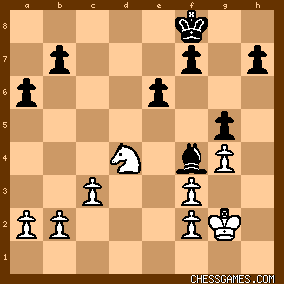
click for larger viewPillsbury certainly has no advantage here. But, of course, he plays boldly for a win. His first plan is to try to exploit his Queen-side pawn majority. 37. Nb3 b6
38. a4
38. Kf1 is the safe and obvious move. But Pillsbury isn't thinking about safety. He is on the attack! 38... Ke8
Rosenthal in the Tournament Book correctly notes that 38...a5 is better. But Mason's move is more than good enough to obtain equality. 39. a5 bxa5
40. Nxa5
Pillsbury now has a passed c-pawn. But can he make anything of it? 40... Kd7
41. Kf1 Bc1
41...Bc7 or 41...Kd6 are better defensive choices, but Mason is still fine here. 42. Nc4 Kc6
Rosenthal calls this move "weak" and claims that the "correct move" was 42...f6. Both moves seem fine to me. There is no reason Mason should lose this game. 43. Ne5+ Kd5
Mason sets a clever trap with this move.
44. Nd3
"Well played." (Rosenthal). As Rosenthal points out in the Tournament Book, Pillsbury could get in trouble had he played the tempting 44. Nxf7 since play would then go 44...Bxb2 45. Nxg5 Bxc3 since all of a sudden Black would have a running a-pawn and a likely win. But Pillsbury doesn't fall for this.
44... Bf4
45. NxB+
Pillsbury decides to seek victory in a King and Pawn ending. 45... gxf4
The position was now as follows:

click for larger viewThis sure looks like a draw. But Pillsbury sees attacking possibilities even here. The manner in which he outplayed Mason from here and obtained a won game in no time flat will be covered in my next post on this game. |
|
Oct-21-17
 | | KEG: Post V
While the position after 45...gxf4 does not appear to present any problems for Black, Pillsbury sees deep into the position and recognizes that he has too important assets: (a) A passed c-pawn; and (b) a target--the Black pawn at h7. Pillsbury also notes that he has one major problem: the chance that the Black King will penetrate his Queen-side if he tries to make an immediate run to capture the h7 pawn. So how to keep all his threats intact while guarding against an invasion by the Black King? 46. b3!
The Black King must be kept off c4. Had Pillsbury played 46. Ke2 here, he would have had the worst of all worlds. Black would play 46...Kc4 and Pillsbury would be on the defensive and would also lose a tempo on his possible King side invasion with his own King. 46... h6?
46...a5 was essential to prevent Pillsbury from playing b4 while keeping his King's options flexible. Another possibility, although not clearly as good, was 46...e5. With the text, Mason gives Pillsbury a free tempo on the King's side. Now Pillsbury's King is one move closer to capturing the Black h-pawn. After the text, it is unclear whether Mason could still hold this ending. 47. Kg2!
Pillsbury heads for the weak h-pawn. Mason now must guard against Pillsbury's King-side threats while keeping an eye on the passed c-pawn. 47... e5??
Mason's only hope was the flexible 47...Ke5 followed--in most variations---by f5. After the text, Mason is lost.
48. Kh3!
Pillsbury's road to victory is clear.
The position was now as follows:
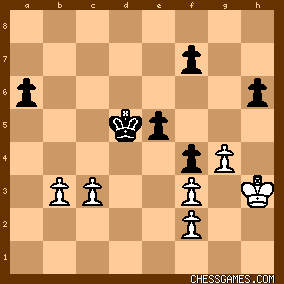
click for larger view48... e4
Rosenthal in the Tournament Book says that 48...a5 was the right move. While that would have been an improvement on the text, it would not have saved the game for Mason (e.g., 48...a5 49. Kh4 e4 50. c4+! and Black is done for). 49. c4+!
Mason now faces brutal threats on both wings. There is no defense. 49... Ke5
Now the game is definitely over. If he wanted to play on, Mason might as well have played to Queen his a-pawn with 49...Kc5--hopeless as this strategy would have been in the long run (e.g., 49...Kc5 50. fxe4 Kb4 51. Kh4 a5 52. Kh5 Kxb3 53. c5 a4 54. c6 a3 55. c7 a2 56. c8(Q) a1(Q)57. Qb8+ Kc2 58. Qc7+ Kd2 59. Qxf4+ Ke2 60. Kxh6 with a clearly winning Queen ending). With the text, Mason will not get a Queen, but Pillsbury will. 50. fxe4 Kxe4
51. c5
51. b4 would also have been crushing.
51... Kd5
52. b4 a5
52...Ke4 would have allowed Mason to hold on for a bit longer, but the outcome is clear in any case. 53. bxa5 Kxc5
54. Kh4 Kb5
55. Kh5 Kxa5
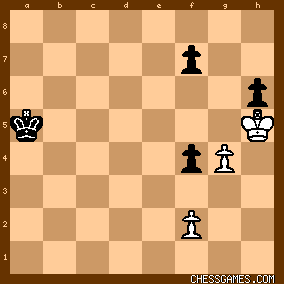
click for larger viewAs is obvious, Mason's King is too far from the action. The game is over. 56. Kxh6 Kb5
57. Kb5
57. Kb7 or 57. g5 would be simpler, but Pillsbury's move is good enough. 57... Kc5
57...f3 would have slightly complicated Pillsbury's task after his last move, but it hardly matters at this point. 58. Kxf4 Kd6
59. Kf5 Ke7
60. g5
1-0
A fine example of Pillsbury's endgame prowess. |
|
| Oct-21-17 | | Retireborn: <KEG> Many thanks for your efforts in elucidating this game. It seems to me that the pawn ending after 46.b3 is completely won for White in all variations. I did wonder if 44...Bd2 might be a better try; White can force the pawn ending with 45.Ke2 Bf4 46.Nxf4+ gxf4 and then the plan with 47.Kf1 doesn't work because after 47...Kc4! Black is on top. Obviously White should play 47.Kd3 and that pawn ending too seems to be won for him. This brings the thought that 42...Kc6 is actually a losing move and your other suggestion of 42...f6 (which prevents Ne5-d3) is the move that holds the draw. |
|
Oct-22-17
 | | KEG: <Retireborn> Thank you for your thoughts and analysis. But I am afraid we disagree on the end of this game. I see no win for White if Black plays 46...a5, so I do not think the pawn ending for White was winning after 46. b3. If after 46 b3 a5 White tries 47. Kg2, Black can simply play 47...e5 and Black has as many threats as does White. For this reason, I cannot agree that 42...Kc6 was the losing move since Black was still fine until at least his 46th move. 42...Bd2 would, in any case, not have been an improvement. If 44....Bd2, Black seems to lose after 45. Ke2 Bf4 46. NxB+ gxN 47. Kd3 with a won pawn ending for White. The position would then be: 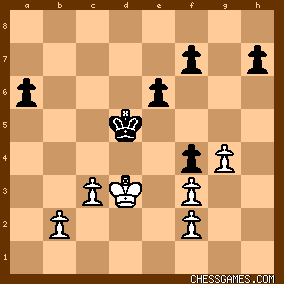
click for larger viewWhatever Black now plays, 48. b4 seems to win for White. I therefore continue to maintain that Black's critical mistakes were 46...h6 (instead of 46...a5) and 47...e5 (47...Ke5 here being the only hope for Black--and perhaps not sufficient). |
|
| Oct-22-17 | | Retireborn: <KEG> OK, thanks. After giving it more thought I see you are right, and it's 46...h6 which loses. Surprising really! |
|
Oct-23-17
 | | KEG: <Retireborn> Yes, it is surprising. I looked at the position for over an hour and checked the result with Fritz before I finally believed it. A single tempo can be fatal in a pawn endgame, and this Pillsbury-Mason encounter is a perfect example. |
|
| Oct-23-17 | | Straclonoor: <A single tempo can be fatal in a pawn endgame, and this Pillsbury-Mason encounter is a perfect example.>
Of course! On my mind best example is Pillsbury vs Gunsberg, 1895 where only 32.e4 wins, other moves goes to lost. Pawn endgame in this game more attractive to white here is best line of Stockfish analysis 1. ± (0.96): 46.b3 a5 47.Kg2 f6 48.Kh3 e5 49.Kh4 Ke6 50.c4 f5 51.gxf5+ Kxf5 52.Kh5 e4 53.fxe4+ Kxe4 54.Kg5 f3 55.Kg4 h6 56.Kg3 h5 57.Kh4 Kd4 58.Kxh5 Kc5 59.Kg4 Kb4 60.Kxf3 Kxb3 61.c5 a4 62.c6 a3 63.c7 a2 64.c8Q a1Q 65.Qe6+ Kb4 66.Qb6+ Kc4 67.Qc6+ Kb4 68.Kf4 Qd1 69.Qe4+ Kc5 70.Qe5+ Kc6 71.Kg5 Qg1+ 72.Qg3 Qh1 73.Qg4 Kd6 74.Qf5 Qg1+ 75.Kh6 Qe1 76.Kg6 |
|
Oct-23-17
 | | KEG: <Straclonoor> Your analysis has caused me to change my mind. Retireborn was correct in his first assessment. White wins this pawn ending after 46. b3 a5
47. Kg2 f6
48. Kh3 e5
49. Kh4 Ke6
50. c4
50. Kh5 I now see also wins.
50... f5
51. gxf5+ Kxf5
52. Kh5 e5
53. fxe4+ Kxe4
54. Kg5
Or 54. Kh6 which also wins
54... f3
55. Kg4 h6
56. Kg3
56. Kh5 also wins
I had undervalued the power of the passed c-pawn in my analysis. BRAVO!
This proves that Mason was lost once he allowed Pillsbury to reduce to a pawn ending. Probably he should have tried 42...f6. Thank you to Retireborn and Straclonoor for uncovering the correct analysis of this pawn ending. Fascinating endgame! Thank you both. |
|
| Oct-24-17 | | Retireborn: My thought was that after 46.b3 a5 47.Kg2 the immediate 47...e5 might be enough to hold the draw; however it does seem that after 48.Kh3 Ke6 49.Kh4 f5 50.Kg5! fxg4 51.Kxg4 White will be able to achieve something very similar to the <Straclonoor> line (which is a Tablebase win for White after 65.Qe6+.) It certainly seems that 42...f6 was at least a more practical defence than going for this pawn ending! |
|
Oct-24-17
 | | KEG: <Retireborn> Yes. Your initial instincts here were correct. Mason should have avoided the pawn endgame, which--on deeper analysis--was a forced win for White. Of course, since even Fritz didn't see the win with a 20-ply search, it is perhaps unfair to fault Mason for missing this. What still seems clear is that 46...h6 lost a tempo and made Pillsbury's task much easier. Has Mason played 46...a5, Pillsbury would have had his work cut out for him to prevail. And Mason's 47...e5 was just awful, after which Pillsbury won in a cakewalk. |
|
| Oct-25-17 | | andrea volponi: 46...a5 -Kg2 Ke5 -Kh3 f5 -Kh4 Kf6 -Kh5 e5 -gxf5 Kxf5 -Kh6 e4 -fxe4+ Kxe4 -c4 f3 -Kxh7 Kd4 -Kg7 Kc5 -Kf6 Kb4 -Kf5 Kxb3 -c5 1-0 |
|
Nov-12-17
 | | KEG: Inspired by the fine analysis by Retireborn, Straclonoor, and andrea volponi, I have reviewed my own analysis of the ending in this game and concluded as follows: 1) The pawn ending after Mason 45. Nxf4+ gxf4 was absolutely won for White after 46. b3: 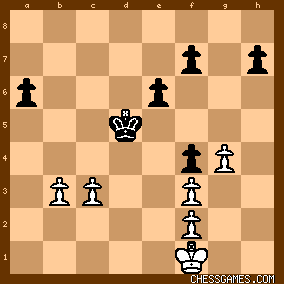
click for larger viewI have played the ending through to mate, and conducted a deep search with Fritz 15 and confirmed that--though Black can reach a Queen ending down a pawn, the ending is a forced win for White. 2) The game was lost by Mason through errors in the minor piece ending. After 36. NxQ the position was as follows: 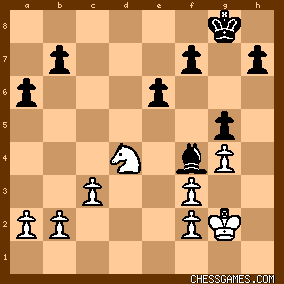
click for larger viewIf anything, Black is better in this ending. But the next few moves turned this around. 36... Kf8
This gives up most or all of Black's advantage. Better was 36...Bc1 or even 36...Bd6 37. Nb3 b6
38. a4 Ke8
39. a5 bxa5
40. Nxa5 Kd7
41. Kf1 Bc1
42. Nc4 Kc6
This was a mistake. Best was 42...Bf4 or 42...Kc7. The move I originally recommended (42...f6) is also better than the text, but 42...Bf4 or 42...Kc7 are easier roads to a draw for Black. 43. Ne5+
The position was now:
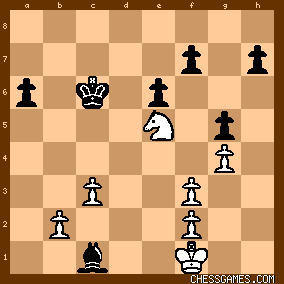
click for larger viewHere Mason played what I have now concluded was the losing move: 43... Kd5?
Black--despite the fact that his Bishop is now dominated by White's Knight--should still be able to hold the game with 43...Kb5. Now, he is lost: 44. Nd3 Bf4
45. NxB+ gxN
46. b3
And White has reached what we now know is a winning pawn endgame. A big thank you to all who helped me see the light in this fascinating endgame. |
|
|
|
|





